Coordinators:
?
Vega rings
Vega PDFs
Vega 1cy August
Vega 1cy September
Vega 1cy October
Vega 1cy November
Vega 1cy December
Vega 2cy January
Vega 2cy February
Vega 2cy March
Vega 2cy April
Vega 2cy May
Vega 2cy June
Vega 2cy July
Vega 2cy August
Vega 2cy September
Vega 2cy October
Vega 2cy November
Vega 2cy December
Vega 3cy January
Vega 3cy February
Vega 3cy March
Vega 3cy April
Vega 3cy May
Vega 3cy June
Vega 3cy July
Vega 3cy August
Vega 3cy September
Vega 3cy October
Vega 3cy November
Vega 3cy December
Vega sub-ad January
Vega sub-ad February
Vega sub-ad March
Vega sub-ad April
Vega sub-ad May
Vega sub-ad June
Vega sub-ad July
Vega sub-ad August
Vega sub-ad September
Vega sub-ad October
Vega sub-ad November
Vega sub-ad December
Vega ad January
Vega ad February
Vega ad March
Vega ad April
Vega ad May
Vega ad June
Vega ad July
Vega ad August
Vega ad September
Vega ad October
Vega ad November
Vega ad December
|
Vega Gull (vegae) 1st cycle / 1CY September
Birds still in fresh juvenile plumage. Later in this month, some advanced birds (early hatched?) may start moult in the upper scapulars, but completely juvenile plumage is the norm.
Do we finally go Vega - part II?
1st cycle birds
2nd cycle & immature birds (this page below)
adult birds
2nd cycle birds
Identification criteria for separating 2nd cycle Vega Gull are scarce, the individual variation is not fully understood and similarity to other taxa in the Herring Gull group is large. Therefore, this text is best regarded as "just an attempt" to create a list of potential identification features for immature birds (all birds not in juvenile or adult plumage).
2nd cycle birds have 2nd generation flight featghers (tail, secondaries, primaries). Typically, for all members of the Herring Gull group, many birds have mostly 2nd gen wing-covert panel and tertials as well. Still, inner wing-coverts and upper tertials may be replaced in a partial autumn moult in 2nd cycle birds, and these replaced feathers are 3rd gen. The exact age of scapulars is hard to determine, much depends on the extent of scapular moult in their 1st cycle.
When 2nd cycles birds have moulted in adult-like grey scapulars, this grey tone excludes the American taxon smithsonianus and the west European taxon argenteus, which are both a shade of grey paler on upperparts; still, Vega grey-tone is about a perfect match to Scandinavian argentatus, which is equally mid-grey on upperparts.
2nd cycle Vega Gull can be classified in two types, both very similar to north European Herring Gulls:
- pale birds, lacking any grey feather in the scapular region and normally with only thin patterned scaps and coverts which result in overall pale birds.
- darker birds, with several adult-like grey scapulars.
Again, on this page the focus is on winter plumage birds, for picking out a heavily worn or moulting immature individual is probably one step too far.
Immature Vega Gull vegae from NE Russia look extremely similar to European birds, and probably a set of scoring traits is necessary for a positive or even diagnostic identification.
Here are some points which may be relevant in identification of 2nd cycle Vega Gull. By discussing these points we may (or may not) be able to compose a diagnostic set, or at least some hierarchy in features:
- upperparts, A: if with adult-like grey scaps, darker than argenteus and smithsonianus, matching argentatus; B: if scaps are patterned, the pattern on scaps and coverts is rather simple and thin, creating an overall pale impression.
- outer visible wing-coverts in resting birds (if not replaced for grey feathers in the partial autumn moult) have much white in the centres and appear unicoloured.
- dark iris, where many European Herring Gulls have pale irides from 2nd cycle onwards.
- Vega Gull can, again like in 1st cycle, be blotchy patterned in the hindneck (contrast between grey back and brown shawl in neck (brown boa).
- obvious large pale window on inner primaries, which may continue in the corresponding greater primary coverts.
- hooded birds can be boldly mottled on the head. This may also be on the forehead, in front of the eye. European Herring Gulls do not seem to show this feature, they have a white forhead. Also, in hooded birds the eye does not stand out, as the iris is dark. When European Herring Gulls are particularly hooded, the beady yellowish eye really stands out.
- rich raspberry pink legs.
- some Vega may already show large white tips on 2nd generation secondaries, making dark centres disappear underneath the greater covert tips, thus creating a white trailing edge in 2nd cycle birds. In European Herring Gulls, the dark secondary centres are much more extensive, visible in flying and preening birds.
It may be difficult even to find 2nd cycle Vega Gull showing the complete list of features. More pictures form Japan, Korea or Russia together with more discussion may help clearing this.
2ND CYCLE VEGA GULL PALE TYPE
Below we start with some example individuals lacking adult-grey scapulars or coverts. They seem to be a minority in the Vega Gull population. Like many European Herring Gull argenteus, Vega Gull seem to be quick in developing a grey scapular saddle. In contrast, argentatus normally appear very immature in 2nd cycle. But remember, there is variation in all three taxa. The mid-grey (Kodak 7) grey tone on upperparts is one of the features to identify Vega Gull, but such feathers are missing in this first group of birds. Best clues probably are:
- dark iris, where 2nd cycle Herring Gulls normally show pale brown or already yellowish irides;
- lack of bold patterns on wing-coverts. Vega Gull is overall rather pale on wing-coverts and scapulars, easiest difference probably found in the outer greater and outer median coverts. In Herring Gull, the visible outer greater coverts and median coverts normally have extensive dark centres or transversal barring. In Vega Gull this is often limited, with an ill-defined thin anchor, and all coverts rather pale over the complete range.
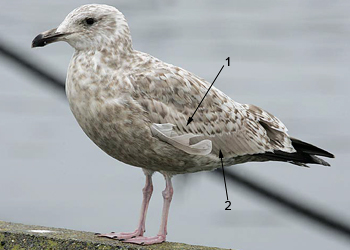 |
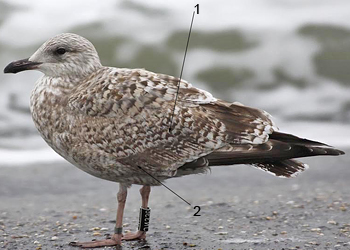 |
| Vega Gull (vegae), 2nd cycle, December 04 2005, Choshi, Japan (Akimichi Ariga). No adult-like grey scaps. Thin patterns on outer median coverts (1) and unicolour greater coverts (2); fresh coverts still with buffish tones, which will bleach to almost white later in winter. Note dark iris. Blotchy pattern on underparts. |
Herring Gull (argentatus) 2nd cycle JN336 January 09 2012, Neeltje Jans, the Netherlands (Pim Wolf). Ringed in N Norway (70°N), HY 2010. No grey scaps, dark iris and fine streaking on head and neck. Many Herring Gull have bold patterns on median coverts (1) and show dark outer greater coverts (2).
|
 |
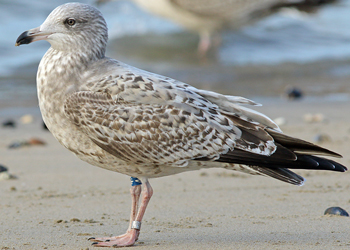 |
| Vega Gull (vegae) 2nd cycle, December 27 2009 - January 04 2010, Choshi, Japan (Chris Gibbins).
Dark iris. No adult-like grey scaps, the pattern on scaps and coverts is rather thin, creating an overall pale impression. Lower lesser coverts with much white in the centres and outer greater coverts only marginally darker, buffish. Note dark iris. |
Herring Gull (argenteus) 2nd cycle 44 December 24 2015, IJmuiden, the Netherlands (Mars Muusse). Example argenteus lacking adult-like grey scapulars. If grey scapulars are present, these are paler than grey scapulars in Vega Gull. Note pale iris and bold contrasting markings on coverts. |
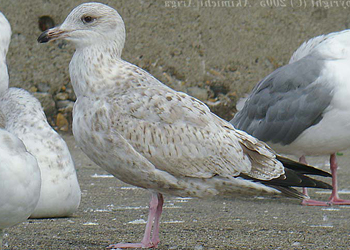 |
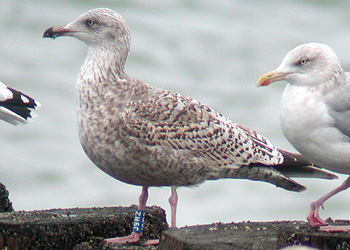 |
| Vega Gull (vegae), 2nd cycle, November 03 2005, Choshi, Japan (Akimichi Ariga). No adult-like grey scaps. Due to delicate thin patterns on coverts and scaps, the overall tone is very pale, almost whitish on upperparts, with tertials darker and only a few lower scaps showing bold patterns. Note dark iris. Birds like this may appear to be promisable. |
Herring Gull (argentatus) 2nd cycle J9RZ November 01 2007, Westkapelle, the Netherlands (Pim Wolf). Ringed in N Norway (70°N). Resembling 1st cycle, but pale eye and mirror on underside of 2nd gen P10. Much white in tail and pale underparts. Pattern on coverts close match to pale Vega, but pale iris completely wrong for 2nd cycle Vega. |
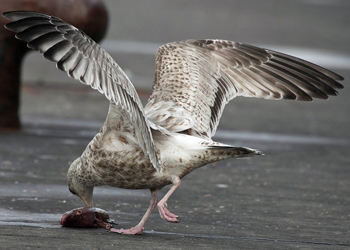 |
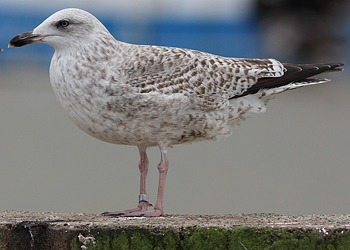 |
| Vega Gull (vegae) 2nd cycle, December 27 2009 - January 04 2010, Choshi, Japan (Chris Gibbins).
Obvious pale window on inner primaries and concolorous greater coverts. |
Herring Gull (argenteus) 2nd cycle GR20814 November 28 2012, Boulogne-sur-Mer, France (Jean-Michel Sauvage). Bold pattern on coverts, pale eye and chequered tertial centres and greater coverts not good for Vega. Much white in tail. |
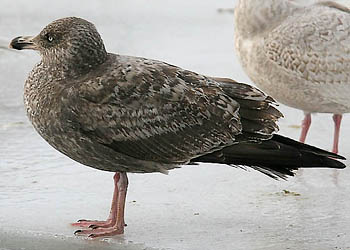 |
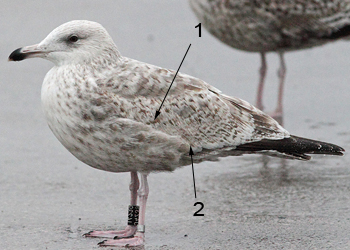 |
| American Herring Gull (smithsonianus) 2nd cycle, February 07 2005, Newfoundland (Jeff Poklen). Can look unicoloured on coverts as well, but often dark aspect on both coverts and underparts. Note pale iris. |
Herring Gull (argentatus) 2nd cycle J4239 January 08 2015, Boulogne-sur-Mer, France (Jean-Michel Sauvage). Ringed in N Norway (69°42'N), HY 2013. Overall a close match to Vega Gull and showing dark iris. In Herring Gull finer streaking on head and neck and old rear lower scap with extensive dark centre. |
2ND CYCLE VEGA GULL DARK TYPE
- The norm for 2nd cycle Vega is dark irides. Norm for Herring Gull is pale / yellowish irides.
- Raspberry pink legs in Vega Gull.
- Vega Gull in 2nd cycle sometimes show a mirror on P10.
- There is often thin vermiculation at the tops of innerwebs of P3-P4, similar to European Herring Gull, but Vega Gull seem to have P1-P2 with just a dark shaft streak (no subterminal arrow or marbling) more often than Herring Gull do.
- Vega Gull often show a distinct contrast between blackish tail and clean white uppertail coverts.
- If any grey tone is present on the fresh feathers, this is a shade darker than on argenteus and on smithsonianus.
- Lack of bold patterns on wing-coverts. Vega Gull is overall rather pale on wing-coverts and scapulars, easiest difference probably found in outer greater and outer median coverts. In Herring Gull, the visible outer greater coverts and median coverts normally have extensive dark centres or transversal barring. In Vega Gull this is often limited, with an ill-defined thin anchor, but all coverts rather pale over the complete range.
 |
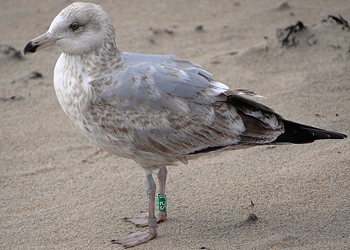 |
| Vega Gull (vegae) 2nd cycle, December 27 2009 - January 04 2010, Choshi, Japan (Chris Gibbins).
Grey tone of fresh scaps is match to argentatus, darker than on argenteus and on smithsonianus. Dark iris and very blotchy pattern in neck and sides of breast. |
American Herring Gull (smithsonianus) 2nd cycle L52 April 13 2013, Hampton beach, NH (Jon Woolf). Banded in 2011. A relatively "advanced" individual, grey tone paler than in Vega Gull. |
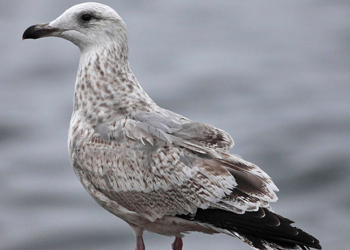 |
|
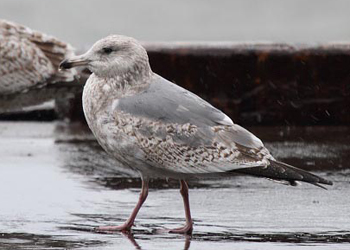 |
 |
| Vega Gull (vegae), 2nd cycle, March 10 2012, Choshi, Japan (Peter Adriaens). Large white tips on 2nd generation secondaries, making dark centres disappear underneath the greater covert tips, thus creating a white trailing edge in 2nd cycle birds. In European Herring Gulls, the dark secondary centres are much more extensive, visible in flying and preening birds. |
American Herring Gull (smithsonianus) 2nd cycle L52 April 13 2013, Hampton beach, NH (Jon Woolf). HY is 2011. A relatively "advanced" individual, grey tone paler than in Vega Gull. Note pale iris and solid dark centres on outer greater coverts. |
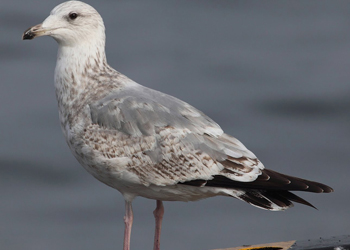 |
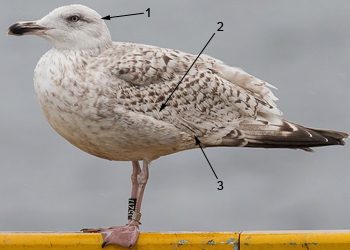 |
| Vega Gull (vegae) 2nd cycle, December 27 2009 - January 04 2010, Choshi, Japan (Chris Gibbins).
Grey tone of fresh scaps is match to argentatus, darker than on argenteus and on smithsonianus. Dark iris and very blotchy pattern in neck and sides of breast. |
Herring Gull (argentatus) 2nd cycle J5217 March 14 2014, Sandøya, Norway (Ingar Støyle Bringsvor). Ringed in January 2013 in Norway, HY 2012. Only few Herring Gulls appear pale on outer greater coverts, like J5217 does. Note pale iris and fine streaking on head and neck. |
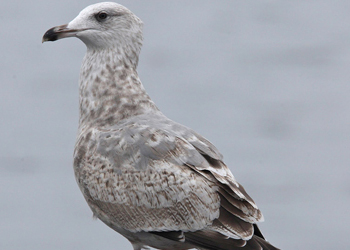 |
|
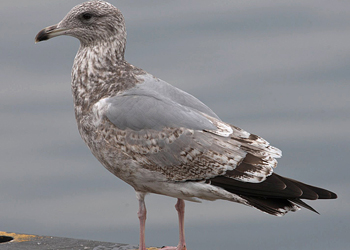 |
|
FLIGHT FEATHER PATTERN ON 2ND CYCLE VEGA GULL
 |
|
| Vega Gull (vegae) 2nd cycle, December 27 2009 - January 04 2010, Choshi, Japan (Chris Gibbins).
Grey tone of fresh scaps is match to argentatus, darker than on argenteus and on smithsonianus. Dark iris and very blotchy pattern in neck and sides of breast. |
|
 |
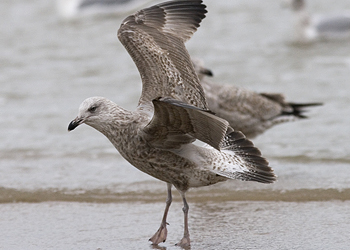 |
| Vega Gull (vegae), 2nd cycle (3CY), March 16 2012, Choshi, Japan (Peter Adriaens). Pale on coverts, even on outermost greater coverts, no dark brown centres. 2nd generation P1-P3 without dark bold tips, overall pale, which continues on the greater primary coverts. Tail-band solid dark in this individual, contrasting with uppertail coverts. |
Herring Gull (argentatus) 2nd cycle, November 26 2013, Katwijk aan Zee, the Netherlands (Mars Muusse). Complete moult finished. Unringed, hence no provenance on origin but overall coloration and jizz suggest nominate argentatus. Pale rump. |
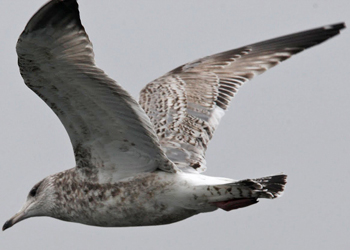 |
 |
| |
American Herring Gull (smithsonianus) 2nd cycle P02 March 05 2012, NH Coast (Keith Mueller). Banded July 15 2010.Classic 2nd cycle plumage with pale panel on inner primaries, and mostly dark outer primaries. |
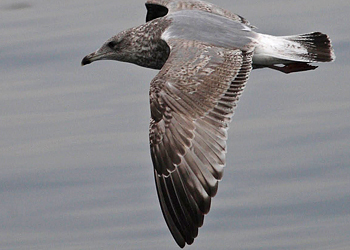 |
 |
| Vega Gull (vegae) 2nd cycle, December 27 2009 - January 04 2010, Choshi, Japan (Chris Gibbins).
Grey tone of fresh scaps is match to argentatus, darker than on argenteus and on smithsonianus. Dark iris and very blotchy pattern in neck and sides of breast. |
American Herring Gull (smithsonianus) 2nd cycle, December 08 2012, Lake County, IL (Amar Ayyash). Classic 2nd cycle plumage with pale panel on inner primaries, and mostly dark outer primaries. |
|
|
 Vega Gull (vegae)
Vega Gull (vegae)  / セグロカモメ
/ セグロカモメ  / 재갈매기
/ 재갈매기 























